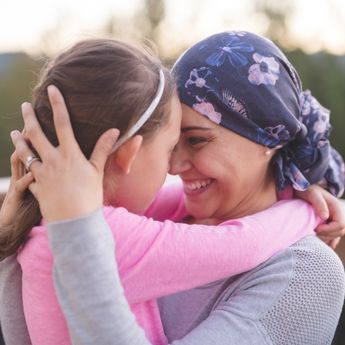By Adriana Ermter
In our monthly column, senior writer and editor Adriana Ermter shares her personal experiences with breast cancer.
If you’re like me, you’ve laughed a lot at the crazy girl math on TikTok and Instagram this past year. Or better yet, you’ve even used it to justify your own spending habits. Like, how you had a $10 credit on your personalized Starbucks card, so bought a hot Americano coffee for $3.95 to sip on your way to work, along with a cold Espresso Frappuccino for $7.95 to drink later. With tax, the total for both came to $13.45, which means that because you only had to pay $3.45 out of pocket the coffees were basically free.
The spending justifications for girl math are funny. But they just aren’t real. And oddly, this type of rationalization reminds me of how many doctors dismiss younger women when they believe that they have breast cancer. I know this because it happened to me. This is how I see girl math being applied to breast cancer.
How girl math is often used to dismiss breast cancer in younger women
You find a lump in your breast, or if you’re like me you feel the lump in your armpit, and you know it’s not supposed to be there, so you go to your doctor to have it examined. Your doctor takes a look and a feel and agrees that something is not right and refers you to a cancer clinic for further testing. But once you get there, take off your clothes and pull on a hospital gown, the oncology specialist tells you that the lump is nothing. The typical breast cancer math isn’t there. You’re too young to have breast cancer, your family has no history with the disease, you don’t have the BRCA1 or BRCA2 genes, there’s no pain, swelling, discolouration or dimpling. And so, you’re told not to worry, that you don’t warrant further testing and you’re turned away. Like girl math, you’re given a “free” pass. Except that also like girl math and the “free” coffees, you do pay because this kind of math never adds up.
The real math for younger women and breast cancer
Too many women, like me, who are under the age of 65, which according to the Canadian Breast Cancer Network is the average age for a breast cancer diagnosis, experience this. I’m facetiously calling it girl math, but its real name is health inequity. And courtesy of this rational, young women who are worried about a possible breast cancer often find themselves being dismissed by our healthcare system. Healthcare professionals disregard our symptoms due to the perception that breast cancer is primarily an older woman's disease and as a result, we are overlooked. Like the Starbucks card and the girl math, there’s always a price to be paid.
Health inequities towards younger women lead to delayed diagnoses. Which means that by the time we are taken seriously, and we are given appropriate testing and breast cancer is detected, it is often at a more advanced stage. But it shouldn’t be this way.
Sure, the Canadian Cancer Society notes that almost 50 per cent of all diagnosis are in women between 50 and 69 years with another 33.4 per cent in women who are 70 years and older. But that shouldn’t translate into younger women being ignored. Younger women like me, who are between the ages 30 and 49 when they first feel a lump account for 16.3 per cent of diagnoses. An additional 0.5 per cent are women 30 years and younger. That’s 16.8 per cent of all breast cancer diagnoses. Breast cancer is in fact, as deemed by the Canadian Cancer Society, the most common cancer among Canadian women. It’s also the second leading cause of death from cancer. So instead of using girl math on us, these statistics should make healthcare experts sit up and give us the attention we deserve. Last year, 80 women from across Canada were diagnosed with breast cancer every single day, while 5,400 women died from it within the same timeframe. Despite our age group being less susceptible, we, the women under the age of 50, get breast cancer too. And the unique set of challenges and disparities in health outcomes that we face because of it make it time for us to be taken seriously.
Breast cancer in younger women is increasing
For starters, breast cancer in younger women is increasing. A 2023 study by the Journal of American Medical Association Network (JAMA) showed that cancers in people, particularly women, increased by 19.4 per cent for those between the ages 30 to 39 and by 5.3 per cent for those between 20 to 29 years, from 2000 to 2019. Breast cancer accounted for the highest number of cases. Yale Medicine agrees, recently stating that breast cancer is the most common cancer among women ages 15 to 39.
For the 50 per cent of us who do not have breast cancer in our DNA through a familial history, there’s no rhyme or reason why. Factors like lifestyle influences, such as alcohol consumption, diet, socioeconomics and pollution, dense breast tissue, pregnancy after age 35 and early menstruation and late menopause (which exposes the breasts to estrogen longer) are however, being explored by experts. Race also plays a role, as noted by a 2020 study by the National Library of Medicine, with black women under the age of 45 being more risk than white women.
The risks younger women with a diagnosis face
Yet, all younger women who are diagnosed face a higher risk of complications, metastatic cancer and mortality. According to the Canadian Cancer Society, breast cancer in women under 40 tends to be more aggressive, diagnosed at later stages and is less responsive to treatment. The reasons behind these statistics are multifaceted, including delayed detection, limited awareness among young women and unique biological features of cancer in this age group.
Plus, having breast cancer can be more detrimental to our emotional wellbeing. That’s because lots of these younger women are like me and single. Without our “person,” going to oncology appointments, having surgery, and undergoing treatment is often experienced solo. We feel alone because we are, and the weight of the responsibility is extremely heavy. The intensity of these emotions can lead to feelings of isolation, guilt, worry and exhaustion. It’s hard to take care of yourself, heal and survive when you’re doing it all on your own. To top it all off, because we are younger, we’re also at greater risk of a recurrence.
Steps you can take for better health equity
Knowing how to manage all of this is daunting, so educating ourselves about breast health and the risk factors is a solid place to start. I’m not talking about WebMD, but rather seeking insight through credible sites geared towards younger women, like Rethink Breast Cancer and the Young Survival Coalition. To overcome dismissal and the denial of testing, self-advocacy is crucial. Do not take no for an answer. If your general practitioner is not on board, get a new one who is. Then, you need to advocate for personalized risk assessments and the screening options tailored to your age and your family history, especially if you don’t have a familial link to breast cancer. If you suspect you have a lump, ask your doctor to book an appointment for a mammogram. Then, when you’re having the mammogram, ask the technician to tell you if you have dense breasts.
Dense breasts mean you have more breast tissue. It is common and normal, especially among younger women. But having dense breasts can also increase your chances of breast cancer and the density of the tissue makes it hard for cancer to be seen during a mammogram. If you have dense breasts, ask for an ultrasound. It’s also more than okay to request a second opinion, seek specialists and voice your concerns. Joining a patient advocacy group can also empower you, as it can help foster a sense of community and mutual support with other women who share your experiences. Talking about breast cancer with other women helps combat stigma, provides perspective and eliminates misinformation. Organizations like Dense Breasts Canada, Rethink Breast Cancer and MyBreastScreening.ca are great resources, as they share accurate, current, and relevant information that can help you communicate your needs with doctors so that you can make the best decisions for your health. Because this is not girl math, it’s your life. Every step we take gets us that much closer to creating health equity for all women, of every age, with breast cancer.
Adriana Ermter is a multi award-winning writer and editor. Her work can be read in Sotheby’s Insight, Living Luxe and IN Magazine, as well as online at 29Secrets.com, RethinkBreastCancer.ca, Popsugar.com and AmongMen.com. The former Beauty Director for FASHION and Editor-in-Chief for Salon and Childview magazines lives in Toronto with her two very spoiled rescue cats, Murphy and Olive. You can follow Adriana on Instagram @AdrianaErmter







